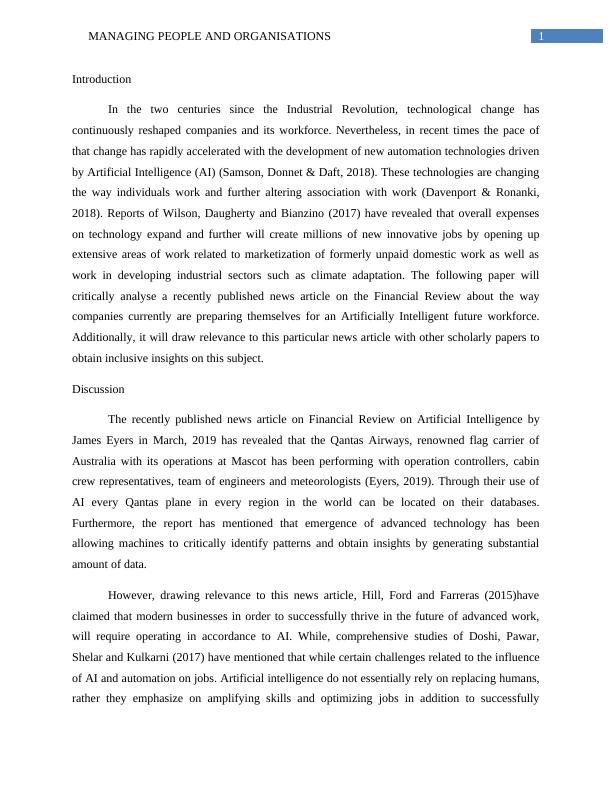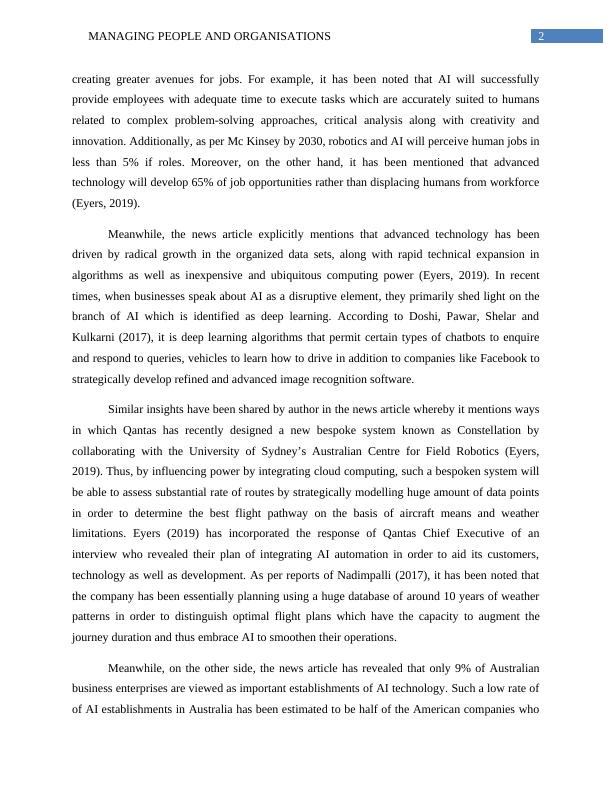Preparing for an AI-Powered Future: Companies Embrace Advanced Technology
Added on 2023-01-19
7 Pages2274 Words64 Views
Running head: MANAGING PEOPLE AND ORGANISATIONS
MANAGING PEOPLE AND ORGANISATIONS
Name of the Student:
Name of the University:
Author note:
MANAGING PEOPLE AND ORGANISATIONS
Name of the Student:
Name of the University:
Author note:

1MANAGING PEOPLE AND ORGANISATIONS
Introduction
In the two centuries since the Industrial Revolution, technological change has
continuously reshaped companies and its workforce. Nevertheless, in recent times the pace of
that change has rapidly accelerated with the development of new automation technologies driven
by Artificial Intelligence (AI) (Samson, Donnet & Daft, 2018). These technologies are changing
the way individuals work and further altering association with work (Davenport & Ronanki,
2018). Reports of Wilson, Daugherty and Bianzino (2017) have revealed that overall expenses
on technology expand and further will create millions of new innovative jobs by opening up
extensive areas of work related to marketization of formerly unpaid domestic work as well as
work in developing industrial sectors such as climate adaptation. The following paper will
critically analyse a recently published news article on the Financial Review about the way
companies currently are preparing themselves for an Artificially Intelligent future workforce.
Additionally, it will draw relevance to this particular news article with other scholarly papers to
obtain inclusive insights on this subject.
Discussion
The recently published news article on Financial Review on Artificial Intelligence by
James Eyers in March, 2019 has revealed that the Qantas Airways, renowned flag carrier of
Australia with its operations at Mascot has been performing with operation controllers, cabin
crew representatives, team of engineers and meteorologists (Eyers, 2019). Through their use of
AI every Qantas plane in every region in the world can be located on their databases.
Furthermore, the report has mentioned that emergence of advanced technology has been
allowing machines to critically identify patterns and obtain insights by generating substantial
amount of data.
However, drawing relevance to this news article, Hill, Ford and Farreras (2015)have
claimed that modern businesses in order to successfully thrive in the future of advanced work,
will require operating in accordance to AI. While, comprehensive studies of Doshi, Pawar,
Shelar and Kulkarni (2017) have mentioned that while certain challenges related to the influence
of AI and automation on jobs. Artificial intelligence do not essentially rely on replacing humans,
rather they emphasize on amplifying skills and optimizing jobs in addition to successfully
Introduction
In the two centuries since the Industrial Revolution, technological change has
continuously reshaped companies and its workforce. Nevertheless, in recent times the pace of
that change has rapidly accelerated with the development of new automation technologies driven
by Artificial Intelligence (AI) (Samson, Donnet & Daft, 2018). These technologies are changing
the way individuals work and further altering association with work (Davenport & Ronanki,
2018). Reports of Wilson, Daugherty and Bianzino (2017) have revealed that overall expenses
on technology expand and further will create millions of new innovative jobs by opening up
extensive areas of work related to marketization of formerly unpaid domestic work as well as
work in developing industrial sectors such as climate adaptation. The following paper will
critically analyse a recently published news article on the Financial Review about the way
companies currently are preparing themselves for an Artificially Intelligent future workforce.
Additionally, it will draw relevance to this particular news article with other scholarly papers to
obtain inclusive insights on this subject.
Discussion
The recently published news article on Financial Review on Artificial Intelligence by
James Eyers in March, 2019 has revealed that the Qantas Airways, renowned flag carrier of
Australia with its operations at Mascot has been performing with operation controllers, cabin
crew representatives, team of engineers and meteorologists (Eyers, 2019). Through their use of
AI every Qantas plane in every region in the world can be located on their databases.
Furthermore, the report has mentioned that emergence of advanced technology has been
allowing machines to critically identify patterns and obtain insights by generating substantial
amount of data.
However, drawing relevance to this news article, Hill, Ford and Farreras (2015)have
claimed that modern businesses in order to successfully thrive in the future of advanced work,
will require operating in accordance to AI. While, comprehensive studies of Doshi, Pawar,
Shelar and Kulkarni (2017) have mentioned that while certain challenges related to the influence
of AI and automation on jobs. Artificial intelligence do not essentially rely on replacing humans,
rather they emphasize on amplifying skills and optimizing jobs in addition to successfully

2MANAGING PEOPLE AND ORGANISATIONS
creating greater avenues for jobs. For example, it has been noted that AI will successfully
provide employees with adequate time to execute tasks which are accurately suited to humans
related to complex problem-solving approaches, critical analysis along with creativity and
innovation. Additionally, as per Mc Kinsey by 2030, robotics and AI will perceive human jobs in
less than 5% if roles. Moreover, on the other hand, it has been mentioned that advanced
technology will develop 65% of job opportunities rather than displacing humans from workforce
(Eyers, 2019).
Meanwhile, the news article explicitly mentions that advanced technology has been
driven by radical growth in the organized data sets, along with rapid technical expansion in
algorithms as well as inexpensive and ubiquitous computing power (Eyers, 2019). In recent
times, when businesses speak about AI as a disruptive element, they primarily shed light on the
branch of AI which is identified as deep learning. According to Doshi, Pawar, Shelar and
Kulkarni (2017), it is deep learning algorithms that permit certain types of chatbots to enquire
and respond to queries, vehicles to learn how to drive in addition to companies like Facebook to
strategically develop refined and advanced image recognition software.
Similar insights have been shared by author in the news article whereby it mentions ways
in which Qantas has recently designed a new bespoke system known as Constellation by
collaborating with the University of Sydney’s Australian Centre for Field Robotics (Eyers,
2019). Thus, by influencing power by integrating cloud computing, such a bespoken system will
be able to assess substantial rate of routes by strategically modelling huge amount of data points
in order to determine the best flight pathway on the basis of aircraft means and weather
limitations. Eyers (2019) has incorporated the response of Qantas Chief Executive of an
interview who revealed their plan of integrating AI automation in order to aid its customers,
technology as well as development. As per reports of Nadimpalli (2017), it has been noted that
the company has been essentially planning using a huge database of around 10 years of weather
patterns in order to distinguish optimal flight plans which have the capacity to augment the
journey duration and thus embrace AI to smoothen their operations.
Meanwhile, on the other side, the news article has revealed that only 9% of Australian
business enterprises are viewed as important establishments of AI technology. Such a low rate of
of AI establishments in Australia has been estimated to be half of the American companies who
creating greater avenues for jobs. For example, it has been noted that AI will successfully
provide employees with adequate time to execute tasks which are accurately suited to humans
related to complex problem-solving approaches, critical analysis along with creativity and
innovation. Additionally, as per Mc Kinsey by 2030, robotics and AI will perceive human jobs in
less than 5% if roles. Moreover, on the other hand, it has been mentioned that advanced
technology will develop 65% of job opportunities rather than displacing humans from workforce
(Eyers, 2019).
Meanwhile, the news article explicitly mentions that advanced technology has been
driven by radical growth in the organized data sets, along with rapid technical expansion in
algorithms as well as inexpensive and ubiquitous computing power (Eyers, 2019). In recent
times, when businesses speak about AI as a disruptive element, they primarily shed light on the
branch of AI which is identified as deep learning. According to Doshi, Pawar, Shelar and
Kulkarni (2017), it is deep learning algorithms that permit certain types of chatbots to enquire
and respond to queries, vehicles to learn how to drive in addition to companies like Facebook to
strategically develop refined and advanced image recognition software.
Similar insights have been shared by author in the news article whereby it mentions ways
in which Qantas has recently designed a new bespoke system known as Constellation by
collaborating with the University of Sydney’s Australian Centre for Field Robotics (Eyers,
2019). Thus, by influencing power by integrating cloud computing, such a bespoken system will
be able to assess substantial rate of routes by strategically modelling huge amount of data points
in order to determine the best flight pathway on the basis of aircraft means and weather
limitations. Eyers (2019) has incorporated the response of Qantas Chief Executive of an
interview who revealed their plan of integrating AI automation in order to aid its customers,
technology as well as development. As per reports of Nadimpalli (2017), it has been noted that
the company has been essentially planning using a huge database of around 10 years of weather
patterns in order to distinguish optimal flight plans which have the capacity to augment the
journey duration and thus embrace AI to smoothen their operations.
Meanwhile, on the other side, the news article has revealed that only 9% of Australian
business enterprises are viewed as important establishments of AI technology. Such a low rate of
of AI establishments in Australia has been estimated to be half of the American companies who

End of preview
Want to access all the pages? Upload your documents or become a member.
Related Documents
Managing People and Organisationlg...
|8
|1517
|351
Impact of Artificial Intelligence on Workforcelg...
|13
|2833
|340
Integration of Artificial Intelligence into Organizationslg...
|9
|2285
|53
Integration of Artificial Intelligence into Organizationlg...
|8
|2332
|93
Disadvantages of Artificial Intelligencelg...
|6
|1412
|142
Impact of Artificial Intelligence on the Business Worldlg...
|7
|1194
|438
